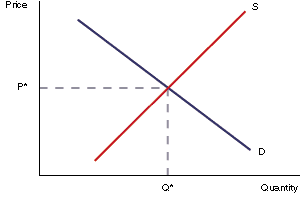Now that we’ve laid out the individual foundations of supply and demand in the translation market, we can bring these two concepts together to discuss another theoretical construct that helps understand translations rates: market equilibrium.
Without delving into mathematical details, the basic idea is that the price on any market is the result of the interplay between the forces of supply and demand. Consumers have preferences and are limited by their disposable income (or budget). Suppliers face cost and technology issues and competition from other suppliers. The ebb and flow of these variables result in a market-equilibrium price at any given point in time.
The most famous graph in Microeconomics
In our case, the supply comes from a group of translators who are offering their services. On the other side are businesses, governments, hospitals, and the like that are in need of translations. Over a period of time, the market will absorb the full range of translation rates being charged and paid for, and the result will be a relative balance, or equilibrium, which is the point at which the market clears.
What does “clearing” mean?
It is an economic term that describes a moment in time when a price has been reached at which supply equals demand. In other words, for our purposes, the translation rate that every translator who is actively offering his or her services is willing and able to accept, and every consumer that is interested in buying translation services is willing and able to pay[1].
The result is that the market clears: there is neither a surplus nor a shortage of translation services.
As you can imagine, this phenomenon never actually happens. Or rather, it happens all the time, and as such, it’s a continuously moving target. In the real world, there is no equilibrium price. There is instead a range of prices that translators and consumers are able to agree upon on any given day. That range of rates will persist over time as long as the market is clearing.
Why does any of this matter?
It goes back to our previous discussions of competition, market power, and variables that affect supply and demand. In order to analyze any of these factors, we need to have a starting point, even if it’s a virtual one that we can never quite put our finger on.
When we have a place to begin, we can then examine the reasons why translation rates are at their current levels, how and why they might change; and what, if anything, we can do on an individual level to affect them.
[1] Of course, there will be translators who are unwilling or unable to accept that rate, along with translation consumers that are unwilling or unable to pay it. They will not be directly involved in the market at this point in time.

